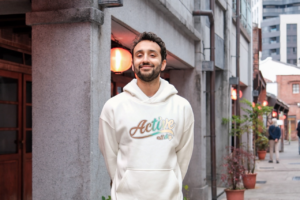I’ll write another section based on “Building the Part-Time YouTuber Academy” heading, maintaining a sophisticated yet accessible tone while drawing from the rich details provided in the transcript.
In the late summer of 2020, as the world adjusted to remote work and digital transformation, a seemingly innocuous tweet from Ali Abdaal posed a simple question: “What’s stopping people from starting a YouTube channel?” The response to this question would catalyze the creation of one of the most successful educational programs in the creator economy, though no one knew it at the time.
The birth of the Part-Time YouTuber Academy (PTYA) offers a masterclass in modern product development. Unlike traditional business launches that often involve months of market research and focus groups, PTYA emerged from authentic community engagement. The flood of responses to Abdaal’s tweet revealed an untapped well of aspiration among professionals and creators who wanted to build their presence on YouTube but lacked the framework to do so.
What followed was a testament to the power of decisive action in the digital age. In just three weeks—a timeframe that would make traditional education providers balk—Parker and Abdaal transformed their sticky-note planning session into a full-fledged curriculum. The initial course structure was ambitious: three weekly sessions, each two hours long, complemented by guest speakers and personalized video feedback. This intensity, which might have seemed overwhelming on paper, proved to be the program’s secret weapon.
The pricing strategy reflected a delicate balance between accessibility and value perception. Initial tiers ranged from £200 to £600, deliberately positioned below typical cohort-based course prices. This decision, while conservative at the time, created a foundation of goodwill that would prove invaluable for future scaling. The market response was nothing short of extraordinary: within 24 hours, the program generated £80,000 in revenue, eventually reaching £300,000 for the first cohort.

But perhaps the most fascinating aspect of PTYA’s evolution is its transformation from a traditional cohort-based course to a sophisticated “done-with-you” service priced at £4,995. This pivot represents a deeper understanding of the creator economy’s maturation. While early adopters sought basic knowledge and community, today’s aspiring creators demand more comprehensive support, including access to team expertise and ongoing mentorship.
The success of PTYA challenges conventional wisdom about online education. While many platforms race to the bottom with low-priced courses, PTYA demonstrated that creators could command premium prices by delivering exceptional value. The program’s evolution from £600 to £4,995 wasn’t just a price increase—it was a fundamental shift in how creator education could be packaged and delivered.
Today, PTYA stands as more than just a course; it’s become an institution within the creator economy. Its success story offers valuable lessons about timing, community building, and the courage to evolve. As Parker notes, the program’s journey reflects a broader truth about the creator economy: the real value often lies not in teaching specific tactics, but in providing comprehensive systems and support that enable creators to build sustainable businesses.
The Academy’s transformation mirrors the broader evolution of the creator economy itself—from a space focused on individual success stories to one increasingly defined by systematic approaches to content creation and business building. In this way, PTYA hasn’t just educated thousands of creators; it’s helped define what professional content creation looks like in the modern era.
At the heart of this system lies what Parker calls the “three-stage framework”: get going, get good, and get smart. This elegant progression mirrors the journey of every successful creator, but it’s the transition from “getting good” to “getting smart” that marks the critical evolution from hobby to business. It’s in this transition that the true sophistication of their approach becomes apparent.
Perhaps most revealing is their inverse approach to content creation. While many creators begin with the video itself, Parker’s team starts with what he calls “the packaging”—the thumbnail, title, and hook. This strategy might seem counterintuitive to traditional content creators, but it reflects a deeper understanding of YouTube’s ecosystem. In a platform where users make split-second decisions about what to watch, the presentation can matter as much as the content itself.
The team’s content management system, built in Notion, offers a glimpse into their methodical approach. Ideas flow through a carefully structured kanban board, where concepts are evaluated not just for their educational value but for their potential to capture and maintain viewer attention. Each piece of content must pass through multiple stages of refinement before reaching production, ensuring that every video serves both the audience’s needs and the channel’s strategic goals.

Their approach to YouTube Shorts demonstrates an equally nuanced understanding of platform dynamics. Rather than simply repurposing existing content, they’ve developed a distinctive editing style that has become a signature of their short-form videos. This wasn’t the result of a grand strategic plan but rather emerged through careful observation and iteration. When an editor’s unique style resonated with audiences, they didn’t just celebrate the success—they systematized it, making it a repeatable element of their content strategy.
What’s particularly fascinating is their deliberate choice to limit YouTube promotion of their paid offerings. While many creators aggressively promote products on their main channel, Parker’s team primarily relies on email marketing and other channels for commercial activities. This strategic decision helps maintain the channel’s educational integrity while building more sustainable customer relationships through dedicated marketing channels.
The sophistication of their content strategy extends to their use of data and analytics. Each thumbnail, title, and hook is treated as a testable hypothesis, with performance metrics informing future creative decisions. Yet they maintain a delicate balance between data-driven optimization and creative intuition, understanding that pure metrics can sometimes lead creators astray from their authentic voice.
In an era where many creators chase algorithms at the expense of quality, Parker’s approach offers a more sustainable path. It’s a reminder that true platform success comes not from gaming the system but from understanding it deeply enough to work within its constraints while maintaining creative integrity.
This strategic approach to content creation has implications beyond just view counts and subscriber numbers. It’s about building a sustainable content ecosystem that can support a multi-million dollar business while continuing to deliver genuine value to its audience. In doing so, they’ve created a blueprint for creators looking to transform their passion into a professional enterprise without sacrificing authenticity or educational impact.

I’ll write a section focusing on “Team Building and Management,” exploring the nuanced approach to building and scaling a creator business team.
In the glossy world of digital media, where individual creators can amass millions of followers, the behind-the-scenes reality of building a sustainable team often remains shrouded in mystery. For Angus Parker, the journey of scaling Ali Abdaal’s team from three people to nineteen—and then strategically back down—offers a masterclass in the delicate balance between ambition and sustainability in creative enterprises.
The traditional corporate playbook for team building, with its emphasis on impressive resumes and years of experience, proves surprisingly inadequate in the creator economy. Parker’s approach represents a dramatic departure from conventional wisdom, prioritizing personality fit and adaptability over traditional credentials. “We’ve learned over the last few years to hire the person rather than the CV,” he notes, a philosophy that has evolved through both triumphs and setbacks.
Their hiring process has evolved into a sophisticated system that begins not with a resume review, but with a two-minute video introduction. This seemingly simple innovation reveals volumes about a candidate’s communication skills, creativity, and cultural fit—factors that prove far more predictive of success than traditional qualifications. It’s a reminder that in the creator economy, the ability to adapt and evolve often trumps fixed skill sets.
The team’s approach to trial tasks represents another departure from conventional hiring practices. Rather than relying on theoretical interviews, candidates engage in real-world projects, typically requiring 30 minutes to two hours of work. While this approach has occasionally faced criticism from candidates who expect payment for trial work, it has proven invaluable in identifying individuals who genuinely connect with the company’s mission.
Perhaps most intriguingly, Parker maintains a strict 60% operating profit benchmark—a number that might seem arbitrary but serves as a crucial guardrail for sustainable growth. This figure has become a north star for team scaling decisions, helping navigate the delicate balance between expansion and sustainability. It’s a reminder that even in the creative economy, financial discipline remains crucial for long-term success.
The team’s evolution mirrors Daniel Priestley’s observation about company scaling: businesses often enter a “desert period” when they grow beyond 12 people but haven’t yet reached the operational sophistication required for 40+ employees. Parker’s experience with scaling to 19 team members, only to later reduce the size, provides a valuable case study in recognizing and navigating these transition points.

Their current approach favors starting new team members as freelancers or contractors before considering full-time positions—a strategy born from experience. This model allows for organic growth and natural role evolution, much like Parker’s own journey from freelance researcher to general manager. It’s an approach that acknowledges the unique dynamics of creator businesses, where roles often evolve in unexpected ways as the business grows.
Most remarkably, the team has managed to maintain its creative output and business growth even while navigating these structural changes. This success speaks to a deeper truth about team building in the creator economy: the goal isn’t to build the largest team possible, but rather to create the most effective team for sustaining and growing the business while maintaining creative excellence.
As the creator economy continues to mature, Parker’s experiences offer valuable insights for others looking to scale creative enterprises. The lessons are clear: prioritize cultural fit over traditional credentials, test for real-world capabilities rather than theoretical knowledge, and maintain strict financial discipline even during periods of rapid growth. In doing so, creator businesses can build teams that not only support current operations but enable sustainable long-term growth.
I’ll write a section focusing on “Future Growth and Scaling Strategies,” exploring how the business is positioning itself for the next phase of expansion.
As the creator economy matures beyond its gold rush era, the question of sustainable growth becomes increasingly crucial. For Angus Parker and the Ali Abdaal enterprise, the future isn’t just about expanding existing revenue streams—it’s about fundamentally reimagining what a creator-led business can become.
The team’s vision for the future reveals a sophisticated understanding of both opportunities and constraints in the digital landscape. Perhaps most notably, they’re developing physical products under a new brand identity, a strategic move that demonstrates their understanding of a crucial truth in the creator economy: the need to build value beyond personal brand attachment.

This pivot toward product development isn’t merely about diversification—it’s about creating transferable value. As Parker astutely notes, “We can’t sell anything that we currently do because everything’s tied to Ali.” This recognition of the need to build sellable assets represents a mature evolution in thinking about creator businesses, moving beyond the traditional model of personality-dependent content creation.
The potential development of a productivity app highlights another fascinating aspect of their growth strategy. Rather than rushing to market with a minimal viable product, their approach reflects a deep appreciation for quality and long-term value creation. “If we do it,” Parker explains, “we want to make sure it’s not just another creator app that’s got Ali’s name on it. We want it to actually be really good and rival productivity apps.”
This commitment to excellence over expediency offers a stark contrast to the often hurried product launches seen in the creator space. It’s an approach that acknowledges the sophistication of modern digital consumers, who increasingly demand genuine utility over celebrity endorsement.
Yet perhaps most intriguing is their strategic pivot from education to productivity. With Ali Abdaal’s upcoming book focused on productivity, the team sees an opportunity to expand into a substantially larger market. While the Part-Time YouTuber Academy reached 4,000 students—a significant achievement in itself—the potential audience for productivity solutions is exponentially larger.
However, this expansion comes with its own challenges. As Parker notes, “Sometimes when something is so big, you can make something that appeals to everyone but appeals to no one.” This awareness of the delicate balance between market size and product focus demonstrates a sophistication in strategic thinking that sets them apart from many creator-led businesses.
The team’s approach to financial planning is equally nuanced. Rather than hiring in anticipation of future revenue—a common pitfall in rapidly growing businesses—they’ve adopted a more measured strategy: make the money first, then hire. This disciplined approach to growth, while potentially slower, creates a more sustainable foundation for long-term success.
Looking ahead, the business stands at a fascinating inflection point. The transition from cohort-based courses to productivity solutions represents not just a pivot in business model but a fundamental shift in how creator-led businesses can evolve. It’s a reminder that in the digital economy, the most successful enterprises are often those that can transcend their original form while maintaining their core value proposition.
For creators and entrepreneurs watching this evolution, the message is clear: sustainable growth in the digital age requires thinking beyond traditional creator business models. It demands building transferable value, maintaining quality standards, and having the courage to evolve beyond initial success formulas.
In the rapidly evolving landscape of digital entrepreneurship, where success stories often burn bright but brief, the thoughtful evolution of Ali Abdaal’s enterprise under Angus Parker’s stewardship offers a masterclass in sustainable business building. Their journey illuminates a path forward not just for content creators, but for anyone seeking to build enduring value in the digital age.
The narrative that emerges is one of deliberate, strategic growth rather than viral sensationalism. From the careful cultivation of multiple revenue streams to the sophisticated approach to team building, every aspect of the business reflects a deeper understanding of what it means to build a sustainable creator enterprise. The team’s revenue model—strategically balanced between content and commerce—demonstrates how creator businesses can evolve beyond simple advertising and sponsorship models.
Perhaps most striking is their approach to value creation. The “99-1-1 principle” (99% free content, 1% paid, and 1% of that 1% premium) represents a sophisticated understanding of modern audience building. It’s an approach that recognizes the paramount importance of trust and value delivery in the creator economy, where audience relationships must be carefully nurtured over time.
Their evolution from cohort-based courses to broader productivity solutions signals a mature understanding of scalable business models. This transition from personality-dependent content to transferable assets marks a crucial evolution in creator commerce—one that other entrepreneurs would do well to study.
As Parker notes, the future holds both promise and challenge. The move into physical products and potential software development represents not just business expansion, but an attempt to create enduring value beyond personal brand. It’s a reminder that in the digital age, true sustainability often requires thinking beyond traditional creator business models.
The lessons here extend far beyond YouTube strategy or course creation. They speak to fundamental principles of modern business building: the importance of systematic thinking, the value of long-term relationship building, and the need for disciplined growth. In an era where many chase quick wins and viral moments, this methodical approach to business building stands out for its sustainability and sophistication.
For creators, entrepreneurs, and business leaders watching this space, the message is clear: the future of digital commerce lies not in personal brand alone, but in building systems, teams, and products that create lasting value. The next chapter of the creator economy will likely belong not to those who can gather the largest audiences, but to those who can transform influence into institutions.
In the end, the story of Angus Parker and Ali Abdaal’s enterprise is not just about building a successful YouTube channel or online education business. It’s about pioneering a new model of digital entrepreneurship—one that balances creative authenticity with commercial sustainability, personal brand with scalable systems, and immediate growth with long-term value creation. As the digital economy continues to evolve, their approach offers a compelling blueprint for building businesses that can thrive well into the future.
In the sleek, glass-walled offices of modern tech companies, conversations about scaling digital businesses often center on venture capital rounds and user acquisition metrics. But in a quiet corner of the creator economy, Angus Parker has orchestrated a different kind of growth story—one that challenges conventional wisdom about what it means to build a sustainable digital enterprise.
As the architect behind Ali Abdaal’s transformation from medical doctor to digital education mogul, Parker has quietly revolutionized how creator businesses can be structured, scaled, and sustained. His journey from sending a speculative email in January 2020 to managing a $5 million annual revenue operation offers a masterclass in modern business building—one that combines the precision of traditional management with the agility demanded by the digital age.
What makes Parker’s story particularly compelling is its departure from the typical creator business narrative. While many digital enterprises rush to monetize through merchandise or hastily assembled courses, Parker’s approach reveals a sophistication more commonly associated with Silicon Valley startups than YouTube creators. Under his stewardship, Ali Abdaal’s business has evolved beyond simple content creation into a multi-faceted operation that spans education, productivity tools, and digital media.
The numbers tell part of the story: $50,000 monthly from YouTube AdSense, up to $100,000 monthly in strategic partnerships, and a newsletter operation generating $20,000 monthly with minimal overhead. But the true innovation lies in the systems and structures Parker has implemented—from a sophisticated content optimization framework to a unique approach to team building that prioritizes cultural fit over traditional credentials.
“The creator economy is entering a new phase,” Parker observes, “one where sustainable business models matter more than viral moments.” This insight has guided the enterprise’s evolution from purely educational content to a broader vision encompassing productivity tools, physical products, and potentially software development—all while maintaining the authenticity that attracted audiences in the first place.
In an industry often characterized by its worship of quick wins and overnight success, Parker’s methodical approach to business building offers a refreshing counterpoint. His story isn’t just about growing a YouTube channel or launching successful courses—it’s about pioneering a new model of digital entrepreneurship that balances creative authenticity with commercial sustainability.
As we delve deeper into the strategies and systems that have driven this success, one thing becomes clear: The future of creator commerce will be built not by those who can simply attract attention, but by those who can transform that attention into enduring value. And in this new landscape, Angus Parker’s blueprint for sustainable growth may well become the standard against which future digital enterprises are measured.
This opening sets up the major themes of the piece while establishing the significance of Parker’s achievements in the broader context of digital entrepreneurship. It also creates a framework for exploring the specific strategies and insights that follow in subsequent sections.
In the rapidly evolving landscape of digital entrepreneurship, where conventional wisdom often feels outdated before it’s even published, Angus Parker’s journey with Ali Abdaal’s enterprise offers a fresh perspective on building sustainable creator businesses. The lessons that emerge from their experience form what might be called a new playbook for digital success—one that challenges traditional assumptions while establishing new benchmarks for operational excellence.
At the heart of their approach lies a fundamental shift in thinking about creator businesses. Rather than viewing content creation as an end in itself, Parker has architected a system where content serves as the foundation for a broader business ecosystem. This perspective transforms the typical creator model from one of constant content production to one of strategic value creation.
The “99-1-1 principle” they’ve developed—where 99% of content remains free, 1% is paid, and 1% of that comprises premium offerings—represents a sophisticated understanding of modern audience building. This isn’t merely a pricing strategy; it’s a philosophy about value creation and audience relationship management that stands in stark contrast to the aggressive monetization approaches common in the creator economy.
Their experience with the Part-Time YouTuber Academy demonstrates the power of thoughtful iteration in product development. Starting with modest cohort-based courses priced at £200-600, they eventually evolved into a premium service commanding £4,995—a transformation made possible not through marketing tactics, but through consistent value delivery and systematic improvement.
The team’s approach to content optimization offers another crucial lesson. By treating each piece of content as a product in itself—complete with careful packaging (thumbnails and titles) and strategic positioning—they’ve developed a repeatable system for success that transcends the typical “post and pray” approach of many creators.
Perhaps most significantly, their current evolution toward productized services and software development points to a crucial truth about sustainable creator businesses: the need to build value beyond personal brand. As Parker notes, “We can’t sell anything that we currently do because everything’s tied to Ali.” This recognition of the need to create transferable assets represents a maturity in thinking that many creator businesses never achieve.
The financial architecture they’ve built—balanced between content monetization and commercial activities—offers a blueprint for sustainable creator businesses. Their maintenance of a 60% operating profit benchmark, while seemingly arbitrary, provides the kind of financial discipline often lacking in creator enterprises.
Yet perhaps the most valuable lesson from their journey is the importance of systematic thinking in creative enterprises. From their hiring processes to their content management systems, every aspect of the operation reflects a balance between creative freedom and operational discipline. This systematic approach, more than any individual tactic or strategy, may be their most significant contribution to the evolution of creator businesses.
For those looking to build sustainable digital enterprises, the message is clear: success in the creator economy requires more than just great content or a large audience. It demands a sophisticated understanding of business fundamentals, a commitment to systematic improvement, and the courage to evolve beyond initial success formulas. In demonstrating how these principles can be applied at scale, Parker and the Ali Abdaal enterprise have not just built a successful business—they’ve helped define what success looks like in the modern digital economy.


